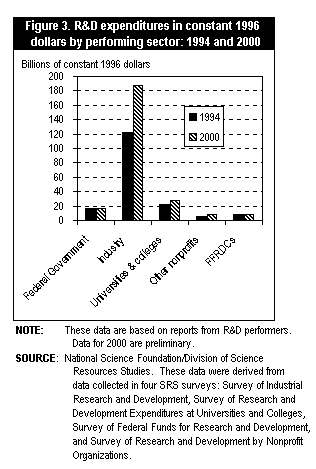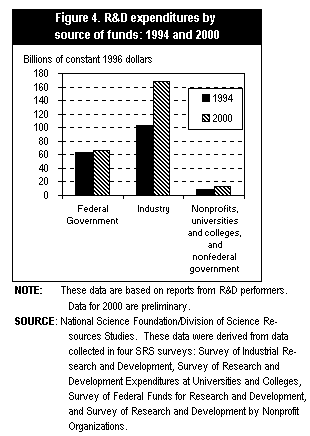Division of Science Resources Studies |
|
 |
Directorate for
Social, Behavioral and Economic Sciences |
|
|
|
National Science Foundation
|
NSF 01-310, November 29, 2000
|
Sixth Year of Unprecedented R&D Growth Expected in 2000
Steven Payson and John Jankowski
R&D continues to grow rapidly since 1994.
The recent growth in R&D was fueled by industry funding.
Although research and development (R&D) expenditures have never been more than 3 percent of the United States’ economy, R&D has been widely recognized as a key ingredient for economic growth, along with such factors as “education, training, production engineering, design and quality control.”[1] Though its precise effects have been difficult to measure, or sometimes even identify, R&D expenditures continue to be studied by scientific and government communities in efforts to understand and improve the patterns of technological change that occur in the economy and society.[2]
Since 1994, R&D in the United States has risen sharply, from $169.2 billion to a projected $264.2 billion in 2000. In “real terms” (adjusting for inflation), that rise has been from $175.9 billion to $249.1 billion in constant 1996 dollars, reflecting an annual real growth rate of 6.0 percent. That increase of $73.2 billion 1996 dollars between 1994 and 2000 is the greatest single real increase for any six-year period in the history of the R&D data series, which begins in 1953 (figure 1). As a component of the economy, that rise might not be very surprising, given that the economy overall has also experienced unprecedented growth. Nonetheless, the consistent pattern of R&D growth that appears to emerge is notable, implying a broad-based, increased interest in the promotion of R&D activities.
Of the projected $264.2 billion spent on R&D in 2000 in “current dollars” (not adjusted for inflation), $45.5 billion (or 17.2 percent) is expected to be for basic research, $56.7 billion (21.5 percent) for applied research, and $162.0 billion (61.3 percent) for development. In comparison with 1994, when growth began to accelerate, R&D performance in 2000 reflects a 5.7-percent real increase per year in basic research, a 5.8-percent real increase per year in applied research, and a 6.1-percent real increase per year in development. (Figure 2 displays these changes in terms of constant 1996 dollars.)
R&D Performance Patterns
Industry—excluding industry-administered Federally Funded Research and Development Centers (FFRDCs)—is expected to perform 75.4 percent of the Nation’s total R&D in 2000 (table 1). The projected $199.2 billion in R&D performance by industry represents an 7.4-percent annual increase in real terms over the 1994 level. (Figure 3 displays this change in terms of constant 1996 dollars.) Of this industrial R&D performance in 2000, 88.2 percent will be supported by industry’s own funds; Federal funding will account for the remaining 11.8 percent. The Federal share of industry’s performance total (excluding industry FFRDCs) has fallen considerably from a high of 31.9 percent in 1987.
Universities and colleges, excluding academically administered FFRDCs, are expected to account for 11.4 percent ($30.1 billion) of national R&D performance in 2000; a real annual increase of 4.0 percent since 1994. The Federal Government is expected to perform 6.7 percent ($17.8 billion) of R&D in 2000, an annual decline in real terms of 0.2 percent over the 1994-00 period. All FFRDCs combined will perform an estimated $9.0 billion of R&D in 2000, or 3.4 percent of the U.S. total. The nonprofit sector is expect to perform $8.2 billion in 2000, or 3.1 percent of the U.S. total.[3]
Funding Patterns
Since 1980, industry has provided the largest share of financial support for R&D, which is projected to reach $179.0 billion in 2000, or 67.7 percent of the total. This funding represents an 8.5-percent increase per year in real terms between 1994 and 2000. (Figure 4 displays this change in terms of constant 1996 dollars.) Of these funds, nearly all ($175.7 billion in current dollars) will be devoted to R&D performed by industry itself in 2000, with the remainder directed toward academic R&D ($2.2 billion) and R&D performed by other nonprofit organizations ($1.1 billion).
Federal R&D support in 2000 is expected to be $71.2 billion, reflecting a 1.0-percent real increase per year since 1994. The Federal share of support for the Nation’s R&D first fell below 50 percent in 1979, and it remained between 45 and 48 percent until 1988. The share then fell steadily, dropping from 45.1 percent in 1988 to 26.9 percent projected for 2000 (the lowest it has ever been since the start of the time series in 1953).
Other R&D funds will be provided by universities and colleges, state and local governments, and other nonprofit institutions. These funds, in combination, are expected to reach $14.0 billion in 2000, reflecting a 5.6-percent real increase per year over their 1994 level.
Basic Research Patterns
The amount of basic research conducted as a proportion of R&D varies enormously by sector. From 1970-2000 basic research was between 66.6 and 77.7 percent of all university and college R&D (excluding university and college administered FFRDCs). For industry R&D (excluding industry-administered FFRDCs) it has ranged between 2.8 and 7.8 percent, and for Federal intramural R&D it has ranged between 12.9 and 19.1 percent. This maximum of 19.1 percent for basic research as a percentage of Federal R&D is expected for 2000, reflecting an upward trend that began in 1990.
Industry is expected to account for 31.0 percent ($14.1 billion) of the Nation’s basic research performance in 2000. Universities and colleges are expected to account for 44.3 percent ($20.1 billion), and their FFRDCs for another 6.0 percent ($2.7 billion). The remaining basic research performance will be carried out by the Federal Government, comprising 7.5 percent ($3.4 billion) of the total; industry-administered FFRDCs, 1.6 percent ($0.7 billion); other nonprofit organizations, 9.3 percent ($4.2 billion); and nonprofit-affiliated FFRDCs, 0.3 percent ($0.1 billion). While Federal Government performance of all R&D is expected to decline in real terms between 1994 and 2000 (as described above), Federal performance of basic research is expected to rise 3.2 percent per year.
International R&D Spending
Due to the size of its economy, the United States spends more on R&D than any other country, though it does not spend as high a proportion of its economy on R&D as some other countries. For example, in 1998, the most recent year for which comparable international data are available, the United States spent 2.59 percent of its GDP on R&D[4], compared to 3.06 percent spent by Japan. It exceeded, however, the shares of 2.18 percent by France, 2.29 by Germany, 1.83 by the United Kingdom, 1.64 by Canada, and 1.02 by Italy. Nondefense R&D as a percent of GDP was 2.2 for the United States in 1998, which was equal to that of Germany (2.2); lower than that for Japan (3.0); and higher than that for France (2.0), the United Kingdom (1.6), Canada (1.6), and Italy (1.0). In the 1990s the proportion of R&D devoted to defense-related activities has declined for nearly all of the group of seven countries, with the possible exception of Japan (though, for Japan, the proportion of R&D that is defense-related has continued to remain relatively small).
User Notes
U.S. R&D expenditures data were assembled from the National Science Foundation’s surveys: Survey of Industrial R&D, Survey of R&D Expenditures at Universities and Colleges, Survey of Federal Funds for R&D, and Survey of R&D Funding & Performance by Nonprofit Organizations. Preliminary estimates for 1999 and 2000 were based in part on time-series modeling and econometric techniques. Foreign R&D expenditure data are derived from national and international sources.
R&D expenditure levels from Federal sources, presented here based on performer-reported surveys, differ from Federal R&D funding totals reported by the Federal agencies that provide those funds. The difference in the Federal R&D totals appears to be concentrated in the funding of industry R&D by the Department of Defense. See National Patterns of R&D Resources: 1998 for detailed discussion and documentation of these differences.
This Data Brief was prepared by:
Steven Payson
Division of Science Resources Studies
National Science Foundation
4201 Wilson Boulevard, Suite 965
Arlington, VA 22230
spayson@nsf.gov
and
John Jankowski
Division of Science Resources Studies
National Science Foundation
4201 Wilson Boulevard, Suite 965
Arlington, VA 22230
jjankows@nsf.gov




